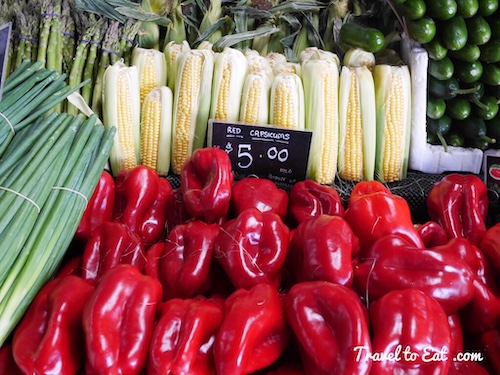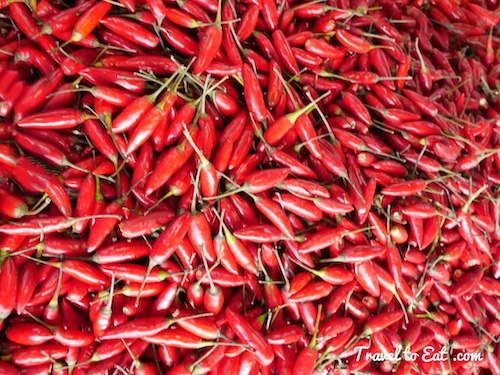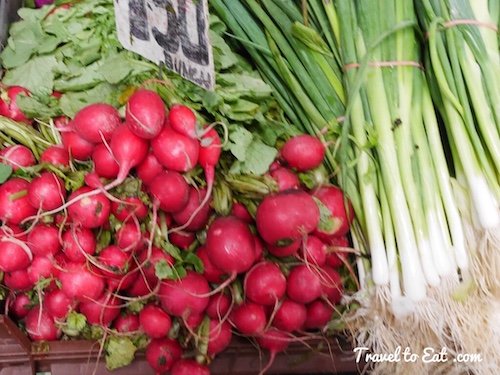
Also known affectionately as ‘Vic Market’ or ‘Queen Vic’, the Queen Victoria Market has been the heart and soul of Melbourne for more than a century. A historic landmark spread over two city blocks, it’s a vibrant and bustling inner-city market where you can shop for everything from Australian fruit and vegetables, and local and imported gourmet foods, to cosmetics, clothing and souvenirs. Because there is so much to see, I have broken the post into fruits and vegetables, this is obviously the vegetable portion. Although the variety of vegetables looks similar to an American supermarket, the species and names are often different. I love farmers markets and while I understand many will find these posts less interesting, you cannot understand the food on your plate without understanding the ingredients. The watchwords of the new cuisine are local, fresh and renewable.

Bell pepper, also known as sweet pepper or a pepper (in the United Kingdom, Canada and Ireland) and capsicum in Turkey, India, Pakistan, Bangladesh, Australia, Singapore and New Zealand, is a cultivar group of the species Capsicum annuum. Cultivars of the plant produce fruits in different colors, including red, yellow, orange, green, chocolate/brown, vanilla/white, and purple. Bell peppers are sometimes grouped with less pungent pepper varieties as “sweet peppers.” Peppers are native to Mexico, Central America and northern South America.

The Banana pepper (also known as the yellow wax pepper or banana chili) is a medium-sized member of the chili pepper family that has a mild, tangy taste. While typically bright yellow, it is possible for them to change to green, red, or orange as they ripen. It is often pickled, stuffed or used as a raw ingredient in foods. In Turkey these are known as village peppers. While called pepperoncini in American English, peppers of this particular kind, in Italy, are called pepperone (plural pepPeroni) like other sweet varieties of peppers, while the term pepperoncii (singular pepperoncino) is used for hotter varieties of chili peppers. The hot varieties of Banana pepper are called Hungarian Wax Peppers. Cultivars include Early Sweet Banana, Hungarian Yellow Wax, Sweet Banana, Sweet Hungarian. Although all of these are varieties of Capsicum annuum they differ quite a lot in terms of heat.

It is interesting that in parts of the world sweet peppers are called capsicum but almost universally hot peppers are called chilis. Chili pepper is native of tropical South America. In 1492, Columbus found chili peppers in West Indies. Columbus thought this was another variety of black pepper. The original name used by Columbus for these peppers was ‘Aji’, a variation of ‘Axi’ (Aztek). The name Chili originated from Nahuatil (Aztec) where Chile was referred to as ‘Red’. This name has died out in United States (because of a ‘State Of Texas’ dish called Chili), but remains in use in UK, Australia and most of Asia. In India its name is literal derivative Lal (Red/Chile) Mirch (Pepper). Portuguese traders introduced Chili pepper to India during 16th century.

The naturally occurring variant of the artichoke, the cardoon (Cynara cardunculus), which is native to the Mediterranean area, has records of use as a food among the ancient Greeks and Romans. Varieties of artichokes were cultivated in Sicily since the classical period of the ancient Greeks, the Greeks calling them kaktos. The Romans called the vegetable carduus (thus the name cardoon). I asked the young man behind the counter and he simply said they were purple artichokes. These might be the much loved in France and Italy purple heirloom variety of artichokes, Globe Artichoke ‘French Purple’, Purple Artichoke, Globe Artichoke ‘Violet de Provence’, Globe Artichoke ‘Violetta di Provenza’ or Globe Artichoke ‘Poivrade’. The alternative is the equally rare oblong Sienna, about four inches in diameter and born of a breeding program in central Italy, with a small choke and a wine red color. Slow to mature and still grown in relatively small quantities, this small artichoke usually weighs less than a pound and has a heart tender enough to be eaten raw.

Broccoli is an edible green plant in the cabbage family, whose large flowering head is used as a vegetable. The word broccoli comes from the Italian plural of broccolo, which means “the flowering crest of a cabbage”, and is the diminutive form of brocco, meaning “small nail” or “sprout”. Broccoli is a result of careful breeding of cultivated leafy cole crops in the Northern Mediterranean in about the 6th century BC. Since the Roman Empire, broccoli has been considered a uniquely valuable food among Italians. Broccoli was brought to England from Antwerp in the mid-18th century by Peter Scheemakers. Broccoli was first introduced to the United States by Italian immigrants but did not become widely known there until the 1920s. The most familiar variety is Calabrese broccoli, often referred to simply as “broccoli”, named after Calabria in Italy.


It is believed that the ancient Egyptians did not cultivate cabbage, which is not native to the Nile valley, though a word shaw’t in Papyrus Harris of the time of Ramesses III, has been interpreted as “cabbage”. The ancient Greeks had some varieties of cabbage, as mentioned by Theophrastus, although whether they were more closely related to today’s cabbage or to one of the other Brassica crops is unknown. The headed cabbage variety was known to Greeks as krambe and to Romans as brassica or olus. Broccoli is a result of careful breeding of cultivated leafy cole crops in the Northern Mediterranean in about the 6th century. Bok choy or pak choi is a type of Chinese cabbage. Chinese varieties do not form heads; instead, they have smooth, dark green leaf blades forming a cluster reminiscent of mustard or celery. Chinese varieties are popular in southern China and Southeast Asia.

Kohlrabi or knol-kohl or German Turnip is a stout, round “tuber” like vegetable which is a low, stout cultivar of cabbage. The part we eat is the enlarged stem from which the leaves develop. The taste and texture of kohlrabi are similar to those of a broccoli stem or cabbage heart, but milder and sweeter, with a higher ratio of flesh to skin. The young stem in particular can be as crisp and juicy as an apple, although much less sweet.

Fennel has been used for its helpful properties for ages. Anciently it was thought to ward off evil spirits, in Roman times it was a symbol of strength and courage. Additionally even then it was known for its properties to sooth the digestive system and other ailments including curbing the appetite and snake bites.

Eggplant or Aubergine originated in cultivation. It has been cultivated in southern and eastern Asia since prehistory. The first known written record of the plant is found in Qí mín yào shù (齊民要術), an ancient Chinese agricultural treatise completed in 544. The numerous Arabic and North African names for it, along with the lack of the ancient Greek and Roman names, indicate it was introduced throughout the Mediterranean area by the Arabs in the early Middle Ages. Eggplant is used in the cuisine of many countries. Eggplant is widely used in its native Indian cuisine, for example in sambhar, dalma (a dal preparation with vegetables, native to Odisha), chutney, curry, and achaar. It is often stewed, as in the French ratatouille, or deep fried as in the Italian parmigiana di melanzane, the Turkish karnıyarık or Turkish and Greek musakka/moussaka, and Middle-Eastern and South Asian dishes.

The avocado (Persea americana) is a tree native to Mexico and Central America, classified in the flowering plant family Lauraceae along with cinnamon, camphor and bay laurel. An avocado is a fruit and not a vegetable! It is actually a member of the berry family. While dozens of cultivars are grown, the Hass avocado is today the most common. It produces fruit year-round and accounts for 80% of cultivated avocados in the world. The original tree was really a mistake – a lucky chance seedling. In the late 1920’s, Mr. Rudolph Hass, who was a postman, purchased seedling trees from A. R. Rideout of Whittier, for the purpose of developing two acres of budded trees of the Lyon variety. Every Hass avocado tree today is descended from that original tree. There is a plaque commemorating the location of the parent tree but the tree died of root rot and was cut down on 9/11/2002 at the ripe old age of 76 (It was planted in 1926). Since the quality was high and the tree gave a good yield, Hass named the variety after himself and took out a patent in 1935.


The parsnip (Pastinaca sativa) is a root vegetable closely related to the carrot and parsley. The parsnip is native to Eurasia. It has been used as a vegetable since antiquity and was cultivated by the Romans, although there is some confusion in the literature of the time between parsnips and carrots. The parsnip was much esteemed and the Emperor Tiberius accepted part of the tribute payable to Rome by Germany in the form of parsnips. It was used as a sweetener before the arrival in Europe of cane sugar. It was introduced into the United States in the nineteenth century. In 1859, a new cultivar called “Student” was developed by James Buckman at the Royal Agricultural College in England. Sweet and delicate best describes the parsnip’s outstanding flavors, while starchy, smooth, and light characterize its texture. Because of its starchy nature, the parsnip can easily stand-in for potatoes in meal planning.

The cultivated carrot is believed to originate from Afghanistan before the tenth century, as this area is described as the primary center of greatest carrot diversity. The first cultivated carrots exhibited purple or yellow roots. Carrot cultivation spread to Spain in the twelfth century via the Middle East and North Africa. In Europe, genetic improvement led to a wide variety of cultivars. White and orange-coloured carrots were first described in Western Europe in the early 1600s. Concomitantly, the Asiatic carrot was developed from the Afghan type and a red type appeared in China and India around the 1700s. Purple (or almost black) carrots grow mostly in southern Europe and Asia. Their characteristic purple or black color comes from pigments called anthocyanins.

Garlic has been used as both food and medicine in many cultures for thousands of years, dating at least as far back as when the Giza pyramids were built. Hippocrates, Galen, Pliny the Elder, and Dioscorides all mention the use of garlic for many conditions, including parasites, respiratory problems, poor digestion, and low energy. Its use in China dates back to 2000 BCE. Its close relatives include the onion, shallot, leek, chive, and rakkyo. Garlic is grown globally, but China is by far the largest producer of garlic, with around 20 million tons (40 billion pounds) grown annually, accounting for over 81% of world output. Chinese Purple is a very unusual garlic in several ways. First, the bulb wrappers have vivid purple stripes on a very white background. Secondly, there is a strong tendency for these softnecks to produce a hardneck and the bulbil capsule at the top of the scape has a very definite turban shape to it. Thirdly, the clove covers are dark brownish-purple. Chinese Purples have a very strong garlic taste with a fierce heat. While they are not the most powerful garlic, they are one potent package.

Ginger is indigenous to southern China, and was spread eventually to the Spice Islands, other parts of Asia and subsequently to West Africa and the Caribbean. Ginger was exported to Europe via India in the first century AD as a result of the lucrative spice trade. India remains the largest producer of ginger. Aromatic, pungent and spicy, ginger adds a special flavor and zest to Asian stir fries and many fruit and vegetable dishes. From its origin to the present, ginger is the world’s most widely cultivated herb. Testimonials of both the medicinal and economic importance of ginger have been recorded as far back as five thousand-year-old Greek literature to 200 B.C.




Bulbs from the onion family are thought to have been used as a food source for millennia. In Bronze Age settlements, traces of onion remains were found alongside date stones and fig remains that date back to 5000 BC. However, it is not clear if these were cultivated onions. Archaeological and literary evidence such as the Book of Numbers 11:5 suggests that onions were probably being cultivated around two thousand years later in ancient Egypt, at the same time that leeks and garlic were cultivated. Workers who built the Egyptian pyramids may have been fed radishes and onions/leeks. Onions are cultivated and used around the world. As a foodstuff they are usually served cooked, as a vegetable or part of a prepared savory dish, but can also be eaten raw or used to make pickles or chutneys. They are pungent when chopped and contain certain chemical substances which irritate the eyes. Leeks were prized by the ancient Greeks and Romans and were especially revered for their beneficial effect upon the throat. The Greek philosopher Aristotle credited the clear voice of the partridge to a diet of leeks, while the Roman emperor Nero supposedly ate leeks everyday to make his voice stronger.

Zucchini, like all squash, has its ancestry in the Americas. However, the varieties of squash typically called “zucchini” were developed in Italy, many generations after their introduction from the Americas. Closely related to zucchini are Lebanese summer squash or kusa (not to be confused with Cushaw), but they often are lighter green or even white. Kusa is the Arabic word for zucchini, which are called courgettes in some countries. This vegetable is widely used in Arab cuisine and the name “kusa” appears in a variety of recipes. Another name for kusa is Lebanese squash or zucchini. As anyone with a zucchini plant will attest, once they begin to produce, one will have an enormous number of zucchini to eat or give away. One must be inventive to use the bountiful crop. I personally love zucchini and eggs, try it and I think you will agree.


Cucumbers are scientifically known as Cucumis sativus and belong to the same botanical family as melons (including watermelon and cantaloupe) and squashes (including summer squash, winter squash, zucchini and pumpkin). Commercial production of cucumbers is usually divided into two types. “Slicing cucumbers” are produced for fresh consumption. “Pickling cucumbers” are produced for eventual processing into pickles. The cucumber originated in India, where a great many varieties have been observed, from Cucumis hystrix. It has been cultivated for at least 3,000 years, and was probably introduced to other parts of Europe by the Greeks or Romans. Records of cucumber cultivation appear in France in the 9th century, England in the 14th century, and in North America by the mid-16th century. The cucumber is listed among the foods of ancient Ur, and the legend of Gilgamesh describes people eating cucumbers. Cucumbers are mentioned in the Bible as one of the foods eaten by the Israelites in Egypt. English cucumbers, also known as hothouse, greenhouse or seedless cucumbers, are typically longer than the regular, garden variety (about 1 foot long) and have a milder flavor. The skin is thinner and it contains smaller, less noticeable seeds. These are the cukes you see at the grocery that are wrapped tightly in plastic.



Cucurbita (Latin for gourd) is a genus of herbaceous vine in the gourd family Cucurbitaceae, also known as cucurbits, native to the Andes and Mesoamerica. Five species are grown worldwide for their edible fruit, variously known as squash, pumpkin, or gourd depending on species, variety, and local parlance. Cucurbita fruits have played a role in human culture for at least 2,000 years. They are often represented in Moche ceramics from Peru. After Christopher Columbus’s arrival in the New World, paintings of squash started to appear in Europe early in the sixteenth century.

The potato was first domesticated in the region of modern-day southern Peru and extreme northwestern Bolivia between 8000 and 5000 BC. It has since spread around the world and become a staple crop in many countries. There are three different categories that species of potatoes can fall into: “Waxy”, “floury” and “all rounders”. “Waxy” potatoes have higher moisture content and less starch, which helps them hold their shape better, making them better suited for salads, stews, as well as soups. “Floury” potatoes have a fluffy texture when cooked because of the higher starch and lower moisture content. This makes them best for baking, mashing and frying, however they release a lot of starch when boiled or fried if not soaked beforehand. “All rounders” are ones that are both waxy and floury. Dutch Cream Potatoes, developed in Holland and dubbed the queen of potatoes, are in the “waxy” category, but they make a beautiful mash with just the littlest bit of salt – No need for butter or cream! These potatoes are large, oval shaped with a waxy, thin yellow skin. The flesh has a rich creamy taste and feel. They’re great for steaming, boiling, baking and roasting.

Also called baby coliban, new potatoes or baby potatoes, chats have a more floury texture than some others. Chat could be an Indian word for small potatoes as in the dish Alu Chat which is tiny boiled potatoes cooled then sliced and sprinkled with salt, cumin, garam masala and lemon juice. Another derivation of chat could be potatoes fed to animals as feed. These were not terribly small but clearly labeled as chat potatoes.

The ‘Désirée’ is a red-skinned main-crop potato originally bred in the Netherlands in 1962. It has yellow flesh with a distinctive flavour and is a favourite with allotment-holders because of its resistance to drought, and is fairly resistant to disease. It is a versatile, fairly waxy variety which is firm and holds its shape, and is useful for all methods of cooking, from roasting to mashing and salads.

A modern potato variety, the Kestrel potato was developed by renowned plant breeder Dr Jack Dunnett in 1992. Kestrels are best known for their unique purple blush, a naturally occurring trait which is passed on from their parent variety, the Cara potato. Perfect for mashing, roasting, boiling and frying, Kestrels are a highly versatile variety with a delicious slightly-sweet flavour. Their even, oval shape and shallow eyes allows for easy preparation.


The kipfler (or German Finger Potato) potato is a waxy, finger-shaped, knobbly potato with yellow skin and a light yellow flesh with a buttery nutty taste that is great boiled, steamed, in salads and roasted but not recommended for frying or chips. Kipfler potatoes are a type of potato known for their unusually long, thin shape. They are generally prepared by being either boiled or steamed, and can be eaten alone or incorporated into a salad or other dish. Due to their relatively low starch content, however, kipfler potatoes are not recommended for mashing or frying. While kipfler potatoes may not be as common as other potato varieties in countries like the US, they are often available in many gourmet and specialty food stores. Perhaps the most unusual feature of kipfler potatoes is their shape. They are generally quite long and thin, and often curve at a rather sharp angle at one or more places along their bodies. Their skins are normally tan in color with darker specks randomly distributed over them, and they tend to have a waxy sheen. The flesh of these potatoes is normally a creamy yellow color.




Agaricus is the genus of the Western World’s most important cultivated mushroom. A. bisporus or the white button mushroom is the white button mushroom of supermarket fame as well as the brown Crimini and Portabello which are cultivars of this same species. The bisporus group (including the Horse mushroom) is responsible for close to $1 billion in yearly sales in Anerica and is heavily cultivated in Europe, China, Australia and many other regions. The King mushroom is an edible mushroom native to Mediterranean regions of Europe, the Middle East, and North Africa, but also grown in many parts of Asia.

This has been a long post but there was a lot to see in Melbourne. I have gone into excruciating detail about the history of these fruits to illustrate just one thing. The history of food is an indispensable guide to the history of civilization. The food that magically appears on our plates is the result of millenia of evolution and selective breeding. These plants come from ancient times and places that span the globe. Our primate ancestors crossed the world, against improbable odds and impossible distances, to create the neolithic revolution, eventually resulting in art, architecture, written history and music. That is the real purpose of this blog, to truly understand our history and our future.
[mappress mapid=”83″]
References:
Website: http://www.qvm.com.au/
Aubergine: http://thestonesoup.com/blog/2010/10/7-things-you-should-know-about-eggplant-5-ingredients/
Black Carrots: http://www.carrotmuseum.co.uk/maroon.html
Australian Potatoes: http://redgem.com.au/potato-varieties/
Potato Varieties: http://www.abc.net.au/tv/pohskitchen/stories/s2914278.htm
Hot Chili Pepers: http://www.cayennediane.com/BigListofPeppers/Big-List-of-peppers.html
Scoville Scale: http://www.indiacurry.com/spice/sz001aboutchili.htm
Purple Artichokes: http://www.saveur.com/article/Techniques/Nine-Artichoke-Varieties
Guardian Garlic Guide: http://www.theguardian.com/lifeandstyle/wordofmouth/2013/oct/08/best-garlic-varieties-lidl-peel-cloves
Gourmet Garlic Gardens: http://www.gourmetgarlicgardens.com/overview.htm
Fennel: http://www.botanical.com/botanical/mgmh/f/fennel01.html
5 Ways to Prepare Kohlarabi: http://www.thekitchn.com/top-five-ways-to-prepare-kohlr-60321
Parsnips: http://www.vegparadise.com/highestperch21.html
Kusa Mukhshi: http://www.dimasharif.com/2012/07/kusa-mukhshi-or-ablama-meat-stuffed.html
Ginger: http://www.herballegacy.com/Whitney_History.html
Squash: http://www.realsimple.com/food-recipes/shopping-storing/food/common-types-winter-squash
Hass Avocado: http://whatscookingamerica.net/avacado.htm
Horse Mushroom: http://mushrooms4health.com/common-edible-agaricus-in-new-england/

